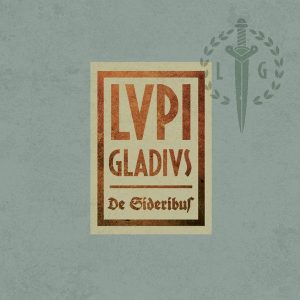
Lupi Gladius – De Sideribus
self-released, lvpi 01
CD/single 2016
Two years ago I had already favourably reviewed Lupi Gladius’ debut album “Veritas”. Now they have released this new single, and it’s good to know these guys have not put aside what had started as a side project of their main band (the renowned electro/wave act “Hidden Place”), but which nonetheless had a remarkable substance, and which I felt was highly innovative for the Italian neofolk scene. As the title suggests (“From the Stars” in Latin), these two songs feature a sidereal and dreamy sound; the punchy rhythms of “Veritas” have been replaced by a layered atmosphere. The synth pads are reminiscent of the sound of Hidden Place, but it’s interesting to listen to them juxtaposed to the typical neofolk acoustic guitar strumming and to the baritone voice of Pietro Burzo. The first song, “L’Armonia del Buio”, features lyrics by Hidden Place singer Sara Lux. In this track the synth layers have an almost orchestral feel where the instrument creates a soothing “wall of sound”. The lyrics of the second track “De Sideribus” have instead been written by Diego Banchero, active as a bass player and author in many Italian projects such as Egida Aurea, Il Segno del Comando and Recondita Stirpe. The coda has an ambient sound, long notes of pad synths, marked by martial timpani and an interesting delay guitar sound. “De Sideribus” is a good completion to “Veritas” and at the same time shows a possible new direction for the next full length, that I hope will come soon – hopefully with more live appearances from this band that has been mostly engaged in studio work.[Damiano Lanzi]
—

Corrina Repp – The Pattern of Electricity
Caldo Verde Records, CV 035
CD 2015
Corrina Repp’s music shows an unusual take on Americana, renewing the heritage of traditional folk and country through modern production techniques, electronics and even some glitch percussions (“Another Shape”). It’s not because she was originally discovered by Mark Kozelek, the man that with his project Sun Kil Moon is actually leading the coordinates for the contemporary alternative folk scene. The best thing about “The Pattern of Electricity” is that it’s not “over”produced: the sound is essential and bright and that leaves ground for Corrina’s voice, warm and full of soul. There are definitely some extraordinary songs in this album; the marvellous vocal melody and string score of “Pattern the Cut/Calm Ass Mofo” is on the same level as the first works by Arcade Fire (and much better than the last ones), the gloomy post-soul track “Woods”, the minimal “Set Fire” and many others. In any of these songs Corrina plays with effects, overdubs and harmonies, but the strength of her vocal expression is always there: a singer-songwriter with a great personality. [Damiano Lanzi]
—

Område – Edari
My Kingdom Music, echo108
CD 2015
When listening to metal music I often have the impression that despite the myriad of highly specific sub-genres that have appeared (mixing heavy music with practically anything else from rap, electronica, industrial, hip-hop et cetera), there is anyway always a tendency to be refractory to further contamination once a band have defined their sound and niche. Luckily that’s not what happens with Område. This duo has no fear of pushing their avant-garde attitude to the extreme, borrowing rhythmic patterns from dubstep, but speeding them at the maximum (“Mann Forelder”), using pop production techniques, but keeping them completely out of their context (the female vocals in “Satellite and Narrow”), or exasperating the solemnity of post-rock music with growl vocals (“Skam Parfyme”). This album is mechanical, technologic and de-humanized, but at the same time eclectic and futuristic, as it happens in the best works by Devin Townsend. Område somehow manage to exceed in every aspect of their music, but it’s a kind of “controlled excess” that seems to be the perfect solution in order to be original and experimental in the field of avant-metal. [Damiano Lanzi]
—

Von Zachinsky – In Sepulchra Regionum
Studio Lemuria, 2015
Despite the gruesome themes of the lyrics and the references in the album title and the opening track to the apocalyptic medieval-Latin poem “Dies Irae”, there is something in this mysterious Polish songwriter that can’t be found in most neofolk acts. On a musical level what I hear is an ironic appeal with regard to the composition of the songs and the choice of musical instruments (circus organs, musical boxes, glockenspiels and many other tiny-sounding toys), along with many inspirations from Eastern-European traditional folk music. There is not much of the percussive martiality of this genre, or at least it’s in the background, as any of these tracks appear at a first glance cheerful and sunny. But then there are some ingredients that contrast with this impression and give to the whole a sinister dark-cabaret feel. Another thing to notice, and that’s not frequent in neofolk, are the technical skills: there are many compelling guitar parts of Gypsy inspiration (“Ohydna Letnia Pogoda”, “Wineta”) and Von Zachinsky’s deep, perfectly tuned voice is capable of some really good interpretations (“Jest Nieskończona Liczba Światów…”, “The Ruin”). [Damiano Lanzi]